Family : Lamnidae

Text © Giuseppe Mazza

English translation by Mario Beltramini
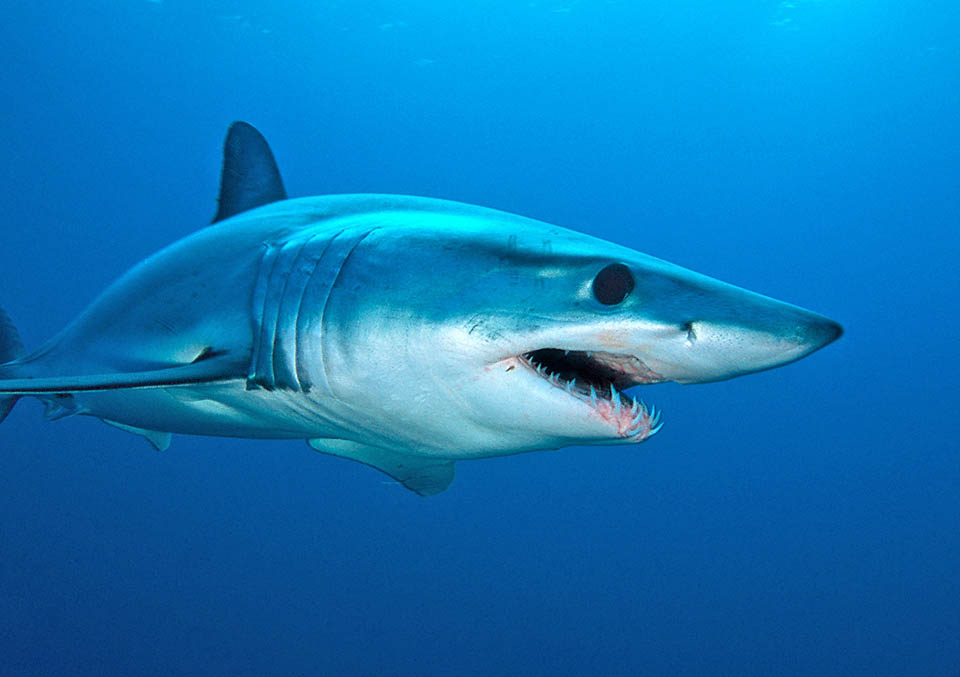
Spindly, with its unmistakable pointed nose, Isurus oxyrinchus is the fastest shark in the world © Obra Shalom Campo Grande
Unmistakable for its pointed nose and its fusiform body, the Shortfin mako shark (Isurus oxyrinchus Rafinesque,1810), is the fastest in the world.
It easily swims faster than 70 km/h and together with the Common thresher (Alopias vulpinus) belongs to the order of the Lamniformes and to the family of Lamnidae.
Like this can raise its body temperature by 2-4 °C compared to the sea one, due to the presence in its sides of an aerobically respiring striated muscle tissue that contracts emitting heat, to which add other inner striated muscles, powered by the so-called “rete mirabile”, formed by venous blood capillaries surrounded by arteries heating them with the warm blood flow coming from the heart.
A thermal increase that allows strong accelerations, spectacular leaps out of the water and a perfect functioning of sight and brain, so much so it does not need the Ampullae of Lorenzini, usually used by sharks and rays for detecting the electromagnetic fields produced by the preys and orient themselves using the Earth’s magnetic field, but goes hunting based solely on sight and smell.
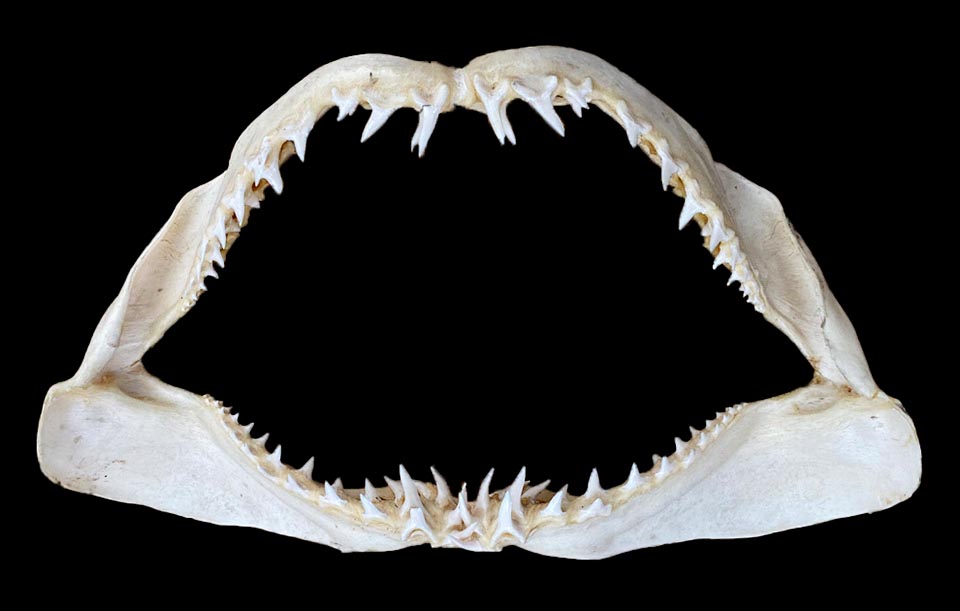
Related to the Great white shark, it has an impressive set of teeth and does not fear divers, at times victims of unjustified fatal attacks © dannydog
In addition it stuns the prey with blows of tail like Alopias vulpinus, and being related also to the Great white shark Carcharodon carcharias) is aggressive with a strong set of teeth and does not fear divers, sometimes victims of unjustified fatal attacks.
The genus Isurus, created by Rafinesque in 1810 from the Greek “isos”, identical and “ourá”, tail, with reference to the lobes of the tail would seem wrong. Maybe it considered them superficially the same or maybe did compare them in his thoughts to those of the immense Common thresher. In fact, even at first sight, the upper lobe of the Shortfin mako shark is decidedly longer than that below.
For the specific term oxyrinchus, from the Greek “oxýs”, pointed , and “rhýnchos”, snout, conversely, there is not the slightest doubt.
Zoogeography
The Shortfin mako shark lives cosmopolitan in the temperate and tropical seas, with a preference for temperatures between 9,7 and 24,4 °C. Therefore it can be met in the Mediterranean, but surely not towards the poles.
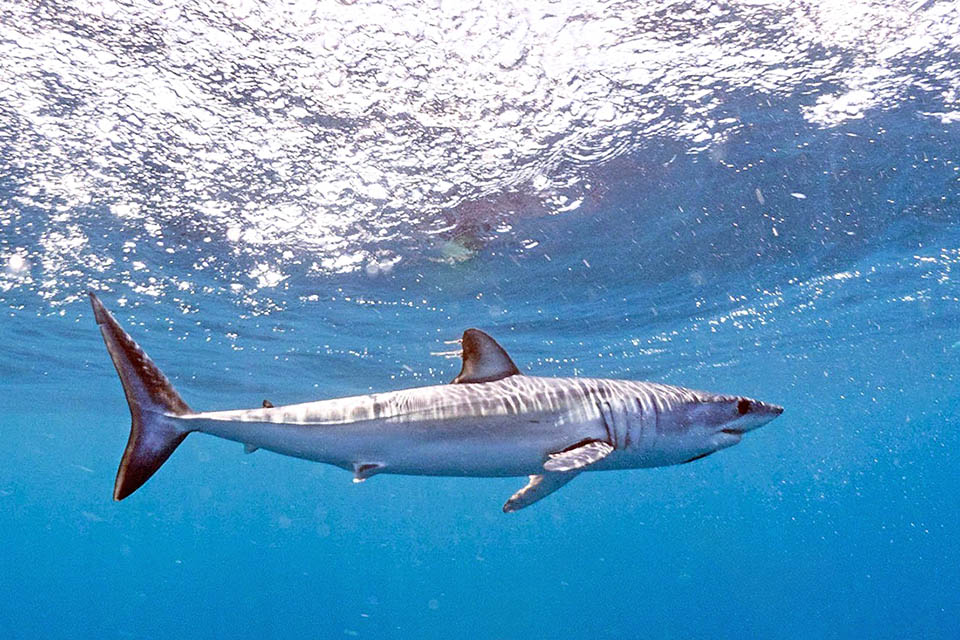
Cosmopolitan in the warm temperate seas, usually measures 270 cm and may increase its body temperature of 2-4 °C compared to the sea © Fernando Olea
In America it is found from California to Chile on the Pacific side, and from Canada and the Caribbean up to Argentina on the other side.
In the east Atlantic, it goes between Norway and South Africa, and is then present in almost all Indian Ocean up to Australia.
In the west Pacific it goes from Japan to New Zealand, and in the central from the Aleutian Islands to French Polynesia.
Ecology-Habitat
Isurus oxyrinchus swims between the surface and 888 m of depth, but prefers to swim between 100 and 150 m for its unbelievable movements. As a matter of fact, a female caught off California was found 2700 km far away in the Central Pacific, and another specimen covered 2128 km in 37 days, at an average of 58 km per day.
Morphophysiology
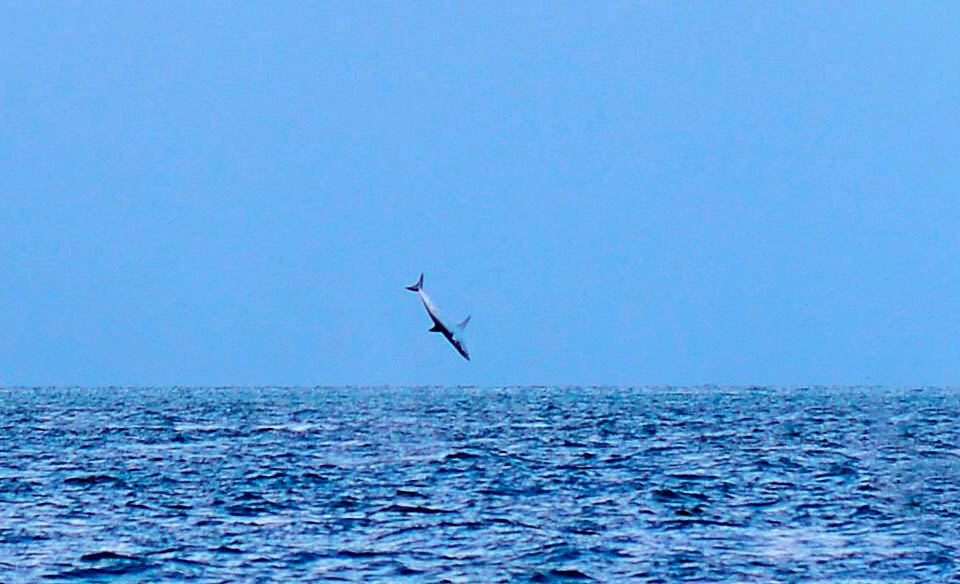
This thermal increase allows it strong accelerations, spectacular leaps out of water and a perfect functioning of sight and of brain © Elias Freyhof
The body, fusiform, metallic blue above and silver white on the belly, may reach 445 cm and 505,8 kg, but the usual size is about 270 cm. The caudal keel is prominent.
The dorsal fin is triangular and both this one and the anal are followed by tiny second fins positioned symmetrically.
The females are bigger than the males and the juveniles distinguish for a blackish dot on the tip of the snout.
Like all Lamniformes, the Shortfin mako shark displays 5 gill slits and immediately catch the eye its characteristic black eyes, surpassed in diametre only by those of the analogous Longfin mako shark (Isurus paucus) Guitart, 1966, rarer and a little smaller, that owes its vulgar name to the ample pectoral fins, cause, conversely, of a slower and less active swimming.
Isurus oxyrinchus is instead continuously moving with surprise attacks from below to snatch fins and sides of the prey with its teeth, pointed and razor sharp. U-shaped, they protrude downwards from the mouth, lined up as if they were in a continuous row.
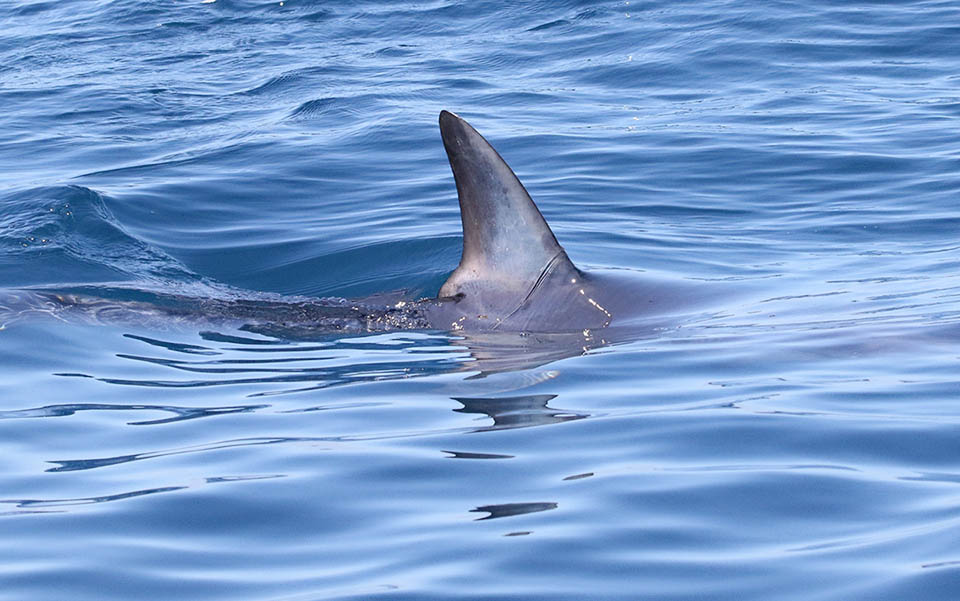
Here it’s alarming dorsal fin in surface. Isurus oxyrinchus attacks with ferocious bites from below sharks, swordfish and dolphins © James Bailey
The bigger ones, triangular and narrow, are hooked without basal cusps or serration, and in the older specimens, that exceed the size of 3 m, the inner teeth, wider and flatter than Isurus paucus, allow to rip open other sharks, swordfish and dolphins, without ignoring the mackerels, the cephalopods and even the turtles and marine birds.
Ethology- Reproductive Biology
Isurus oxyrinchus is an ovoviviparous species that gives birth to 4-18 young after a 15-18 months long pregnancy. The internal fertilization may also happen by multiple males, and the young, once the yolk is used up, feed on the unfertilized eggs, respecting, unlike other sharks, the other growing fetuses.
Upon birth the newborns measure 60-70 cm with a lifespan of almost 30 years.
Even if precise data are not available, the resilience of Isurus oxyrinchus is low, with a minimal time of 4,5-14 years for doubling the populations, and the fishing vulnerability, decidedly high, marks 79 on a scale of 100.
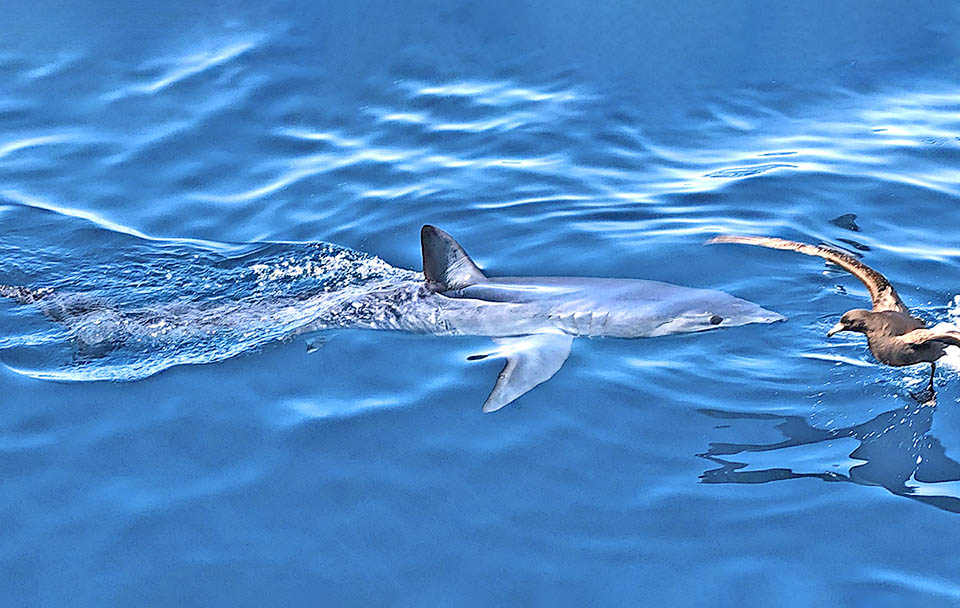
It feeds on mackerels, cephalopods and even turtles and marine birds. Too caught, however appears close to extinction, in the IUCN Red List © James Bailey
In fact the Shortfin mako shark is hunted by sport fishermen who do appreciate its combativeness, not to talk about memorable photos or souvenir teeth, in defiance to the prohibitions is caught due to its excellent flesh and the oil rich in vitamins present in its liver.
Since 2016 it obviously appears as “ED, Endangered” in the IUCN Red List of the endangered species.
Synonyms
Isurus spallanzani Rafinesque, 1810; Squalus cepedii Lesson, 1831; Isurus cepedii (Lesson, 1831); Lamna oxyrhina Cuvier & Valenciennes, 1835; Oxyrhina gomphodon Müller & Henle, 1839; Oxyrhina glauca Müller & Henle, 1839; Isuropsis glaucus (Müller & Henle, 1839); Lamna glauca (Müller & Henle, 1839); Lamna latro Owen, 1853; Isuropsis dekayi Gill, 1862; Carcharias tigris Atwood, 1869; Isurus tigris (Atwood, 1869); Lamna guentheri Murray, 1884; Isurus guentheri (Murray, 1884); Lamna huidobrii Philippi, 1887; Isurus mako Whitley, 1929; Isuropsis mako (Whitley, 1929); Isurus bideni Phillipps, 1932; Isurus tigris africanus Smith, 1957; Isurus africanus Smith, 1957.
→ For general information about FISH please click here.
→ For general information about CARTILAGINOUS FISH please click here.
→ For general information about BONY FISH please click here
→ To appreciate the BIODIVERSITY of CARTILAGINOUS FISH please click here.
→ To appreciate the BIODIVERSITY of BONY FISH please click here.
